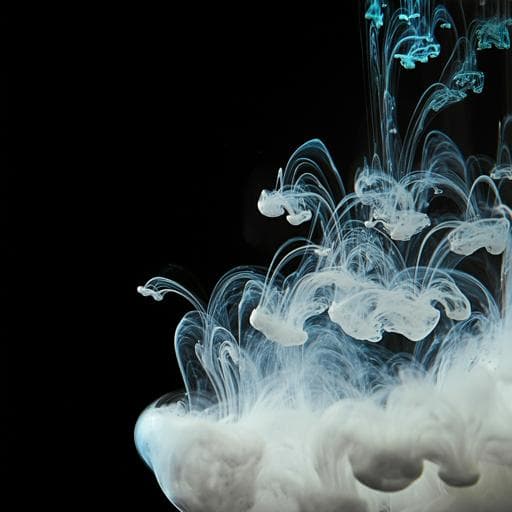
Humanities
Beauty and chemistry: the independent origins of synthetic lead white in east and west Eurasia
B. Han, B. Zhang, et al.
Discover the groundbreaking research by Bin Han, Bei Zhang, Jianrong Chong, Zhanwei Sun, and Yimin Yang, which reveals the independent origins of synthetic lead white in East and West Eurasia. This fascinating study sheds light on how the quest for beauty spurred significant chemical innovations over a millennium ago.
~3 min • Beginner • English
Introduction
The study investigates the origins and manufacturing methods of synthetic lead white in east Eurasia and its connection to cosmetic use. While lead white—a mixture primarily of hydrocerussite and cerussite—was widely employed in antiquity for painting and cosmetics, early uses often relied on mined natural cerussite. In Europe, a synthetic corrosion method using vinegar vapor, heat, and CO2 emerged in Greece by the fourth century BCE and became predominant. For east Eurasia, clear historical or scientific evidence for lead white synthesis in the first millennium BCE was lacking, leading to competing hypotheses: independent Chinese invention (as speculated from ancient recipes) or technology transfer from Europe or Egypt. The research addresses this gap by analyzing white residues from eighth-century BCE cosmetic containers at the Liangdaicun site in northern China to determine their composition, method of manufacture, carbon sources, and chronology, thereby clarifying whether synthetic lead white appeared independently in the east and its role in beauty practices.
Literature Review
Prior work documents early exploitation of mineral pigments and development of synthetic pigments such as Egyptian Blue, phosgenite, China Purple, and Maya blue, all linked to art and cosmetics. Lead white has a long history in cosmetic and artistic contexts, including Egyptian Graeco-Roman cartonnage and Fayum portraits, and became ubiquitous in European paintings by the late Middle Ages. The earliest method of obtaining white pigments involved mining natural cerussite across regions like southern Europe, Egypt, Mesopotamia, Iran, and the Indus Valley. Synthetic production in Europe adopted the corrosion method by the fourth century BCE, recorded by Theophrastus, Vitruvius, Pliny, and Dioscorides, with AMS radiocarbon dating confirming early Greek synthetic lead white. For east Eurasia, historical records are unclear; Needham posited a Chinese invention by the fifth century BCE based on an ancient recipe, while others suggested introductions from Europe or Egypt. The absence of direct 14C dating of lead carbonates in east Eurasian archaeological contexts left the early synthesis scenario unresolved. This study contributes to this debated literature by providing analytical and chronological evidence from Liangdaicun.
Methodology
Archaeological context: The Liangdaicun site (Hancheng, Shaanxi, northern China) is a nobility cemetery of the Rui state in the early Spring and Autumn Period (~8th century BCE). Miniature bronze vessels interpreted as cosmetic containers were excavated from tombs M26 (queen Zhongjiang), M27 (king Ruigong), and M300 (aristocratic female). White residue aggregates were found inside six miniature bronze containers; samples were coded LW-1 to LW-6.
Microscopy: Digital microscopy with Keyence VHX600. SEM-EDS using Phenom XL. Samples sprinkled on carbon adhesive; SEM at 15 kV, 1.2 nA; EDS at 15 kV, 8 nA.
FTIR: Nicolet 6700 FTIR with ATR accessory; 4000–500 cm⁻1, 4 cm⁻1 resolution, 32 scans; small residue portion placed on ATR platform.
XRD: Rigaku MiniFlex II, Cu Kα (λ=1.5406 Å); sample ground and mounted on Si tablet (1.5×1.5 cm) using ethanol; 30 kV, 15 mA; divergence slit 1.25°, anti-scattering slit 1.25°, receiving slit 0.3 mm; 2θ range 10–75°, scan speed 3°/min. Approximate contents of PbCO₃ and Pb₂Cl₂CO₃ estimated from peak areas.
Stable C/O isotopes and AMS 14C: Samples pretreated in <0.1 N HCl to remove surface carbonate; rinsed to neutral, dried at 110 °C for 12–14 h, inspected microscopically. Under vacuum, acid hydrolysis with 10% phosphoric acid at 80 °C for 2 h generated CO2 for dating/IRMS (applicable since samples are pure lead carbonates). CO2 collection followed by AMS radiocarbon dating and IRMS at Beta Analytic; calibration against IntCal20/updated atmospheric curve.
Sampling and context recording included residue location (lid, wall, bottom) and associated vessel codes; mineral identification cross-validated by FTIR/XRD and morphology by SEM. Approximate phosgenite proportions were estimated via XRD peak area comparisons.
Key Findings
- Composition: FTIR showed characteristic cerussite (PbCO₃) peaks at 678, 838, and 1050 cm⁻1 for all samples; additional peaks at 758, 648, 638 cm⁻1 indicated phosgenite (Pb₂Cl₂CO₃) in LW-1a and LW-5. XRD confirmed PbCO₃ as main component; phosgenite ~5% in LW-1a, ~60% in LW-5.
- Morphology: Cerussite crystals exhibit elongated pseudo-hexagonal, acicular, and prismatic forms, consistent with precipitation in solution rather than corrosion processes (which typically yield hydrocerussite plus cerussite with grainy/short prismatic habit).
- Isotopes: δ13C values are light (−15.6‰ for LW-1a; −18.8‰ for LW-2a), indicating organic carbon sources, especially C3 plants, rather than solely atmospheric CO2.
- Radiocarbon: Measured AMS radiocarbon concentrations: 69.78 ± 0.26 pMC (LW-1a) and 70.22 ± 0.26 pMC (LW-2a). Calibrated ages show a small offset earlier than the tomb M26 burial date (coffin lacquer 14C), attributed to incorporation of wood/plant-derived carbon during synthesis.
- Contextual evidence: Large aggregations of pure PbCO₃ crystals confined to miniature bronze containers; inner surfaces show no corrosion; absence of typical bronze corrosion copper compounds; no phosphorus detected by EDS and no pyromorphite in FTIR, supporting synthetic origin.
- Synthesis route: Evidence supports a precipitation method starting from PbO dissolved in vinegar to form lead acetate, followed by carbonation via CO₂ or plant-ash-derived carbonate (K₂CO₃). Presence of Cl⁻ likely induced PbCl₂ formation and subsequent conversion to phosgenite/cerussite depending on pH.
- Chronology and significance: These residues constitute the earliest known synthetic lead white (eighth century BCE), predating Greek synthetic production and indicating independent development in east Eurasia using a route distinct from the Greek corrosion method.
- Sociocultural: Lead white was used by both elite women and men (kings/queens, aristocrats) and aligns with the rise of cosmetics in the Spring and Autumn period; the innovation likely facilitated widespread cosmetic and artistic use, contributing to a broader cosmetic revolution.
Discussion
The multiproxy evidence—mineralogical (FTIR/XRD), morphological (SEM), isotopic (δ13C), and chronological (AMS 14C)—demonstrates that the Liangdaicun white residues are synthetic lead carbonates created via precipitation in solution, not natural cerussite or corrosion-derived products. Light δ13C values and slight 14C offsets relative to burial are consistent with incorporation of C3 plant carbon (e.g., from wood ash or combustion CO₂), explaining the modest pre-burial age shift and differentiating them from natural cerussite, which would show much older ages. Detection of phosgenite, rare in nature, further corroborates synthesis in chloride-bearing solutions. The crystal habit supports precipitation rather than corrosion processes. Together, these findings answer the research question by establishing an independent eastern tradition of lead white synthesis in the eighth century BCE using a precipitation method—lead acetate formation from litharge and vinegar followed by carbonate precipitation—distinct from the Greek corrosion method that relied on vinegar vapors and fermenting materials. The work reframes early Chinese chemical practice, indicating wet chemistry with vinegar as a reagent occurred about a millennium earlier than previously documented textual records, and highlights how aesthetic demands (white cosmetics) catalyzed chemical innovation. The broader implications include a parallel, independent evolution of lead white technology across Eurasia and its role in enabling mass production and widespread cosmetic/artistic adoption.
Conclusion
This study identifies the earliest known synthetic lead white, produced by a precipitation method in the eighth century BCE at the Liangdaicun site, predating previously known examples and demonstrating independent origins of lead white synthesis in east and west Eurasia. The method involved dissolving litharge in vinegar to form lead acetate, then carbonating to precipitate cerussite (and phosgenite when chloride was present). These findings push back the timeline for wet inorganic chemistry in ancient China by roughly a millennium and show that cosmetic needs spurred chemical innovation. The mass production and lower cost of synthetic lead white contributed to a cosmetic and artistic revolution across Eurasia. Future research should trace the subsequent development and transmission of precipitation-based lead white technologies, explore divergent eastern and western patterns, and integrate broader humanities, natural, and social science perspectives to refine understanding of ancient chemical practices.
Limitations
- The precise carbon source(s) used during synthesis cannot be unambiguously identified; distinguishing contributions from atmospheric CO2, wood combustion, plant ash carbonate, or admixtures remains complex and is acknowledged as an open question.
- AMS 14C dates show slight offsets relative to tomb burial dates, likely due to plant-derived carbon inputs and/or minor admixture with earlier materials; exact quantification of such mixing is uncertain.
- No direct archaeological evidence (e.g., devices) for controlled CO2 bubbling exists for the first millennium BCE; carbonation pathways are inferred from chemical plausibility and product phases.
- The evolutionary trajectory of precipitation-based lead white production in China after the first millennium BCE is largely unknown due to limited datasets and textual ambiguity/secrecy in craft traditions.
- Lipid binders were not identified in the analyzed residues; functional interpretations (storage vs. ready-to-use cosmetics) rely on contextual inference of the vessel set.
Related Publications
Explore these studies to deepen your understanding of the subject.







